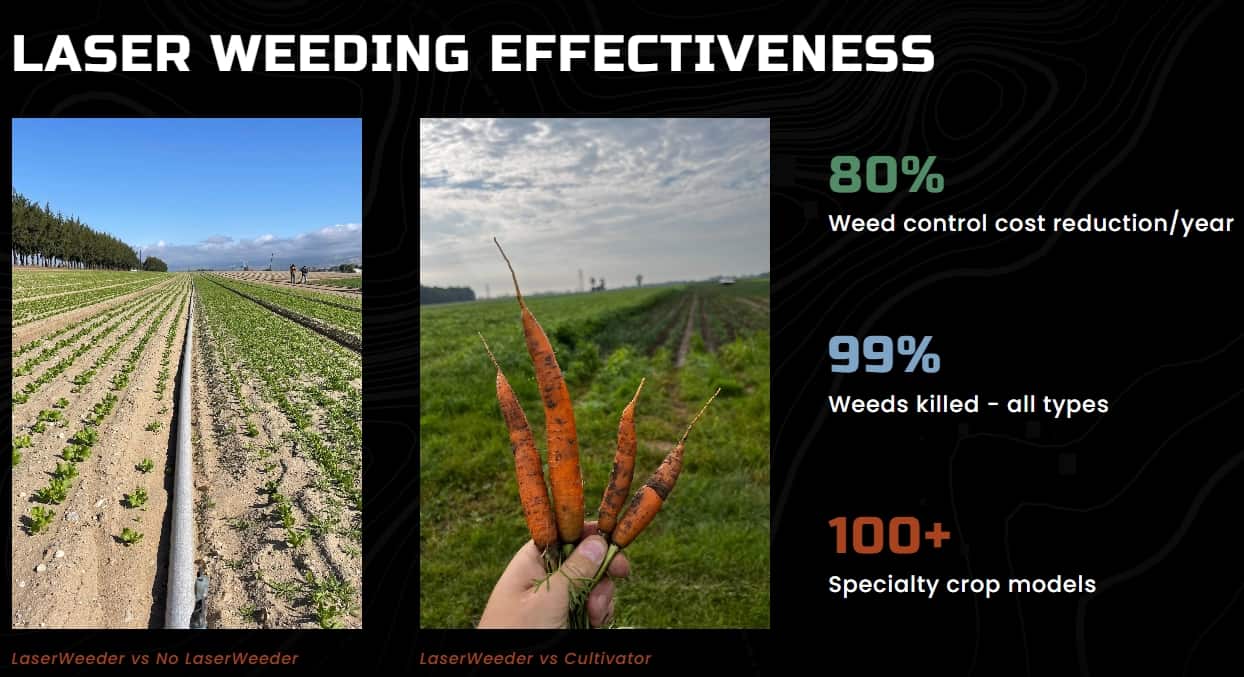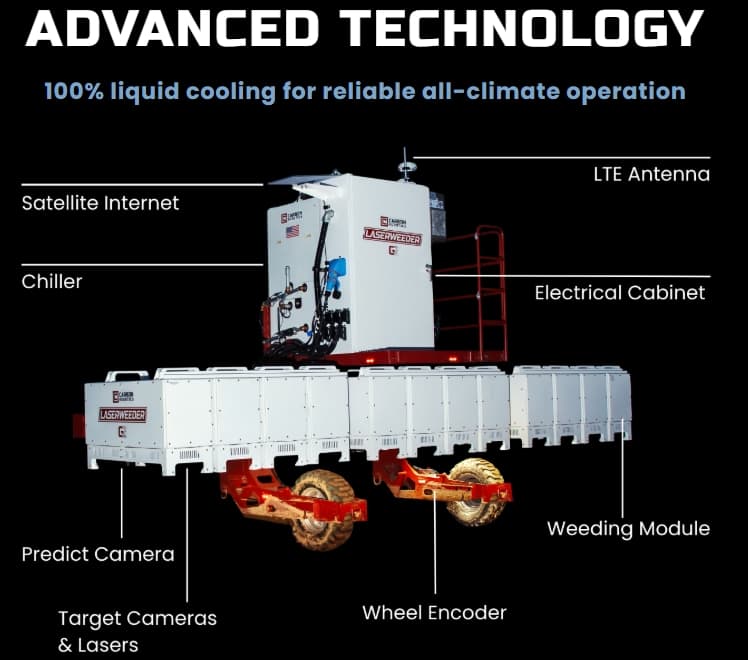Introduction
Carbon Robotics has emerged as a transformative force in the agricultural robotics sector, revolutionizing traditional farming practices through its innovative LaserWeeder technology. As the agricultural industry faces mounting pressures from labor shortages, environmental concerns, and the need for sustainable farming practices, Carbon Robotics uses artificial intelligence and laser technology for no-till, chemical-free weed control in specialty crops. This comprehensive analysis examines Carbon Robotics' market position, product evolution, and the valuable insights it offers for Chinese agricultural technology companies seeking to capitalize on the booming agtech market.(Carbon Robotics: https://carbonrobotics.com )

Carbon Robotics: Company Overview and Market Position
The LaserWeeder Revolution
Founded in 2018, Carbon Robotics has established itself as the pioneer in laser-based weed control technology. The company's flagship product, the LaserWeeder, represents a paradigm shift from traditional herbicide-dependent farming to precision, AI-driven weed management. The device, which weighs 9,500 pounds, aims to cut weed control costs by 80% and increase crop yield and quality.
The LaserWeeder's core technology combines several cutting-edge components:
- 42 high-resolution cameras providing sub-millimeter accuracy
- AI-powered computer vision for real-time crop and weed identification
- Precision laser systems capable of targeting individual weeds
- Advanced robotics for autonomous field navigation
Financial Performance and Market Validation
Carbon Robotics' impressive funding trajectory demonstrates strong investor confidence in the AI agriculture sector. This new funding round will help Carbon Robotics scale its LaserWeeder business, introduce new software and hardware products, and more. Since its inception, the company has raised nearly $144 million, with a significant $70 million funding round in October 2024.
This financial backing has enabled rapid product development and market expansion, positioning Carbon Robotics as a leader in the agricultural robotics space.
Carbon Robotics Product Portfolio Analysis
LaserWeeder G2: The Next Generation
In February 2025, Carbon Robotics unveiled its most advanced product line to date. Carbon Robotics, the leader in AI-powered farming, today debuted LaserWeeder G2, its new product line that combines the latest AI, computer vision, robotics and laser technology for precision weed control. LaserWeeder G2's faster, lighter and modular design makes precision weeding available to a broader range of farming operations.
Product Comparison: LaserWeeder Evolution
| Feature | Original LaserWeeder | LaserWeeder G2 | Track LaserWeeder |
|---|---|---|---|
| Weight | 9,500 lbs | Lighter design | Track-mounted |
| Speed | Standard processing | Faster, lighter, and more power-efficient than its predecessor | Enhanced mobility |
| Design | Fixed configuration | Modular system | Track-based |
| Target Market | Large-scale farms | Diverse farm sizes | Specialty terrain |
| Launch Year | 2018–2021 | 2025 | 2024 |
Key Product Advantages
- Precision Technology: High-resolution cameras and an onboard supercomputer identify crops and weeds in real time
- Cost Efficiency: Cut Costs by 80% Increase Yield & Quality Smart Investment · Eliminate hand labor, reduce labor costs and address labor shortages
- Environmental Benefits: Chemical-free weed control reduces environmental impact
- Versatility: Compatible with 100+ crop types across various soil conditions

Global Agricultural Robotics Market Analysis
Market Size and Growth Projections
The agricultural robotics market is experiencing unprecedented growth across multiple forecasting models:
| Source | 2024/2025 Market Size | Projected Size (2030-2033) | CAGR |
|---|---|---|---|
| Grand View Research | USD 14.74 billion in 2024 | USD 48.06 billion by 2030 | 23.0% |
| Fortune Business | $8.13 billion in 2025 | $26.35 billion by 2032 | 18.3% |
| Verified Market Research | USD 16.42 Bn in 2024 | USD 170.74 Bn by 2031 | 34% |
| Straits Research | USD 9.65 billion in 2024 | USD 25.7 billion by 2033 | 11.5% |
China's Agricultural Robotics Market Opportunity
The Chinese market presents particularly compelling opportunities. China Agriculture Robots Market is predicted to reach $2.93 billion by 2030 with a CAGR of 17.5%% from 2023 to 2030. This growth trajectory positions China as a critical market for agricultural robotics innovation and adoption.
Strategic Insights for Chinese Agricultural Technology Companies
1. Technology Development Focus Areas
AI and Computer Vision Integration Chinese companies should prioritize developing sophisticated AI algorithms capable of:
- Real-time crop and weed identification
- Adaptive learning for different regional growing conditions
- Integration with existing farm management systems
Modular Design Philosophy Following Carbon Robotics' LaserWeeder G2 approach, Chinese manufacturers should emphasize:
- Scalable solutions for diverse farm sizes
- Modular configurations allowing customization
- Cost-effective entry points for smaller operations
2. Market Entry Strategies
Domestic Market Development
- Focus on China's vast agricultural sector with region-specific crop adaptations
- Develop partnerships with local agricultural cooperatives
- Create financing models accessible to small and medium-scale farmers
Technology Differentiation
- Explore alternative precision agriculture technologies beyond laser weeding
- Consider multi-functional robotic platforms
- Integrate with China's digital agriculture ecosystem
3. Competitive Advantages for Chinese Companies
Manufacturing Cost Efficiency Chinese companies can leverage manufacturing advantages to:
- Offer competitive pricing compared to Western alternatives
- Develop cost-effective versions for emerging markets
- Scale production rapidly to meet growing demand
Local Market Understanding
- Adapt technology to local crop varieties and farming practices
- Navigate regulatory requirements more effectively
- Build stronger relationships with domestic customers
Future Outlook and Market Trends
Emerging Technologies in Agricultural Robotics
The success of Carbon Robotics demonstrates the viability of precision agriculture technologies. Key trends shaping the industry include:
- Multi-functional Robotics: Integration of weeding, planting, and harvesting capabilities
- Sustainable Agriculture: Reduced chemical dependency driving technology adoption
- Labor Shortage Solutions: Eliminate hand labor, reduce labor costs and address labor shortages
- Data-Driven Farming: Advanced analytics and reporting platforms
Investment and Innovation Opportunities
The substantial funding raised by Carbon Robotics ($70 million in 2024) indicates strong investor appetite for agricultural robotics solutions. Chinese companies should consider:
- Strategic partnerships with international technology providers
- Investment in R&D for proprietary technology development
- Exploring government initiatives supporting agricultural modernization
Challenges and Considerations
Technical Challenges
- Adaptability: Ensuring technology works across diverse crop types and growing conditions
- Cost-Benefit Analysis: Making ROI compelling for different farm sizes
- Maintenance and Support: Building robust service networks for complex equipment
Market Challenges
- Farmer Adoption: Overcoming traditional farming method preferences
- Regulatory Compliance: Meeting safety and environmental standards
- Competition: Differentiating in an increasingly crowded market
Recommendations for Chinese Agricultural Technology Companies
Short-term Strategies (1-2 years)
- Technology Assessment: Evaluate Carbon Robotics' approach and identify improvement opportunities
- Market Research: Conduct detailed analysis of Chinese agricultural robotics demand
- Partnership Development: Establish relationships with agricultural research institutions
- Pilot Programs: Launch small-scale demonstrations with progressive farmers
Medium-term Strategies (3-5 years)
- Product Development: Create competitive alternatives adapted to Chinese market needs
- Manufacturing Scale-up: Build production capacity for domestic and export markets
- Technology Integration: Develop comprehensive agricultural robotics ecosystems
- International Expansion: Explore opportunities in other emerging agricultural markets
Long-term Vision (5+ years)
- Global Leadership: Position Chinese companies as leaders in specific agricultural robotics niches
- Innovation Ecosystem: Create integrated platforms combining hardware, software, and services
- Sustainable Agriculture: Drive global adoption of environmentally friendly farming technologies
Conclusion
Carbon Robotics' success with the LaserWeeder demonstrates the immense potential of AI-powered agricultural robotics. Carbon Robotics announced five milestones and product launches with press releases, which helped spread the word to media, customers, stakeholders and the public, showcasing the company's rapid growth and market validation.
For Chinese agricultural technology companies, Carbon Robotics provides a valuable blueprint for success while highlighting opportunities for innovation and differentiation. The global agricultural robotics market's projected growth to over $48 billion by 2030, combined with China's specific market potential of $2.93 billion, represents a significant opportunity for well-positioned companies.
The key to success lies in combining technological innovation with deep understanding of local agricultural needs, competitive manufacturing capabilities, and strategic market positioning. By learning from Carbon Robotics' approach while adapting to local market conditions, Chinese companies can play a crucial role in transforming global agriculture through AI and robotics technology.
As the agricultural industry continues its digital transformation, companies that can deliver effective, affordable, and scalable robotic solutions will be well-positioned to capture significant market share in this rapidly growing sector. The lessons from Carbon Robotics' journey provide valuable insights for navigating this exciting and challenging market landscape.